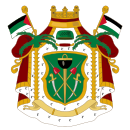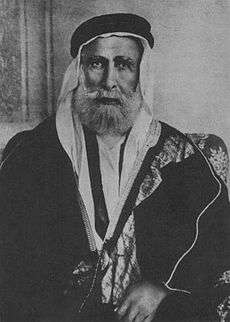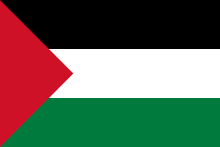Kingdom of Hejaz
The Hashemite Kingdom of Hejaz (Arabic: المملكة الحجازية الهاشمية, Al-Mamlakah al-Ḥijāzyah Al-Hāshimīyah) was a state in the Hejaz region in the Middle East (modern-day western Saudi Arabia), the western portion of the Arabian peninsula ruled by the Hashemite dynasty. It achieved national independence in 1916 after the destruction of the Ottoman Empire by the British Empire during World War I when the Sharif of Mecca fought in alliance with the British Imperial forces to drive the Ottoman Army from the Arabian Peninsula during the Arab Revolt.
Hashemite Kingdom of Hejaz المملكة الحجازية الهاشمية Al-Mamlakah al-Ḥijāzyah Al-Hāshimīyah | |||||||||||||
|---|---|---|---|---|---|---|---|---|---|---|---|---|---|
| 1916–1925 | |||||||||||||
 Coat of arms
| |||||||||||||
 Kingdom of Hejaz (green) on the Arabian Peninsula. | |||||||||||||
| Capital | Mecca | ||||||||||||
| Common languages | Arabic | ||||||||||||
| Religion | Sunni Islam | ||||||||||||
| Government | Absolute monarchy | ||||||||||||
| King | |||||||||||||
• 1916–1924 | Hussein bin Ali | ||||||||||||
• 1924–1925 | Ali bin Hussein | ||||||||||||
| Historical era | World War 1 Interwar period | ||||||||||||
• Kingdom established | 10 June 1916 | ||||||||||||
| 10 August 1920 | |||||||||||||
• Foundation of the Sharifian Caliphate | 3 March 1924 | ||||||||||||
| 19 December 1925 | |||||||||||||
• Ibn Saud crowned King of Hejaz | 8 January 1926 | ||||||||||||
| Area | |||||||||||||
| 1920 | 250,000 km2 (97,000 sq mi) | ||||||||||||
| Population | |||||||||||||
• 1920 | 850,000 | ||||||||||||
| Currency | Hejaz pound, Maria Theresa Thaler | ||||||||||||
| |||||||||||||
| Today part of | |||||||||||||
The new kingdom had a brief life and then was conquered in 1925 by the neighbouring Sultanate of Nejd under a resurgent House of Saud, creating the Kingdom of Hejaz and Nejd.[1]
On 23 September 1932, the Kingdom of Hejaz and Nejd joined the Saudi dominions of al-Hasa and Qatif, as the unified Kingdom of Saudi Arabia.[2][3]
History

In their capacity as Caliphs, the Sultans of the Ottoman Empire would appoint an official known as the Sharif of Mecca. The role went to a member of the Hashemite family, but the Sultans typically promoted Hashemite inter-familial rivalries in their choice, preventing the building of a solid base of power in the Sharif.

With the outbreak of the First World War in 1914, the Sultan, in his capacity as Caliph, declared a jihad against the Entente powers. The British in particular hoped to co-opt the Sharif as a weighty alternative religious figure backing them in the conflict. The British already had a series of treaties with other Arab leaders in the region and were also fearful that the Hejaz could be used as a base to attack their shipping to and from India. The Sharif was cautious but, after discovering that the Ottomans planned to remove and possibly murder him, agreed to work with the British if they would support a wider Arab revolt and the establishment of an independent Arab kingdom — the British implied they would. After the Ottomans executed other Arab nationalist leaders in Damascus and Beirut, the Hejaz rose against and soundly defeated them, almost completely expelling them (Medina remaining under Ottoman control throughout).
In 1916, the Sharif of Mecca Hussein bin Ali declared himself King of Hejaz as his Sharifian Army participated with other Arab forces and the British Empire in expelling the Turks from the Arabian peninsula.[4][5]
The US State Department quotes an aide-mémoire dated 24 October 1917 given by the Arab Bureau to the American Diplomatic Agency in Cairo confirming that
...Great Britain, France and Russia agreed to recognize the Sherif as lawful independent ruler of the Hedjaz and to use the title of "King of the Hedjaz" when addressing him, and a note to this effect was handed to him on 10 December 1916.[6]
The British, though, were compromised by their agreement to give the French control of Syria (comprising modern-day Syria and Lebanon) and did not, in Hussein's eyes, honour their commitments. Nevertheless, they did eventually create Hashemite-ruled kingdoms (in protectorate form) in Jordan and in Iraq, as well as Hejaz. The changing boundaries of the Ottoman Hejaz Vilayet contributed to uncertainties between the neighbouring Hashemite kingdoms, particularly the competing claim with Transjordan over the inclusion of the sanjak of Ma'an, including the cities of Ma'an and Aqaba.
Hussein refused to ratify the 1919 Treaty of Versailles, and in response to a 1921 British proposal to sign a treaty accepting the Mandate system stated that he could not be expected to "affix his name to a document assigning Palestine to the Zionists and Syria to foreigners."[7] A further British attempt to reach a treaty failed in 1923–24, and negotiations were suspended in March 1924;[8] within six months the British withdrew their support in favor of their central Arabian ally Ibn Saud, who proceeded to conquer Hussein's kingdom.[9]
The League of Nations Covenant provided for membership to the signatories of the Peace Treaties; the Hejaz was one of three (the other two were the United States and Ecuador) that failed to ratify Versailles.[10][11]
Kings of Hejaz
- Hussein bin Ali (10 June 1916 – 3 October 1924)
- Ali bin Hussein (3 October 1924 – 19 December 1925)
See also
References
- Yamani, M. (2009), Cradle of Islam: the Hijaz and the quest for an Arabian identity (Pbk. ed.), I.B. Tauris, ISBN 978-1-84511-824-2
- Al-Rasheed, M. A History of Saudi Arabia. Cambridge, England, UK: Cambridge University Press, 2002.
- A Brief overview of Hejaz - Hejaz history
- Baker, Randall (1979), King Husain and the Kingdom of Hejaz, Cambridge, England. New York: Oleander Press, ISBN 978-0-900891-48-9
- Teitelbaum, Joshua (2001), The rise and fall of the Hashimite Kingdom of Arabia, New York University Press, ISBN 978-0-8147-8271-2
- Division of Near Eastern Affairs (1931). Mandate for Palestine (PDF) (Report). US State Department. p. 7.
- Mousa 1978, p. 185.
- Huneidi 2001, p. 71-2.
- Huneidi 2001, p. 72.
- Christian J Tams. "League of Nations, B.2.Membership". Oxford University Press. Retrieved 2 June 2019.
- LoN Hejaz, HC Deb 17 March 1930 vol 236 c1714.
Bibliography
- Huneidi, Sahar (2001). A Broken Trust: Sir Herbert Samuel, Zionism and the Palestinians. I.B.Tauris. p. 84. ISBN 978-1-86064-172-5.CS1 maint: ref=harv (link)
- Mousa, Suleiman (1978). "A Matter of Principle: King Hussein of the Hijaz and the Arabs of Palestine". International Journal of Middle East Studies. 9 (2): 183–194. doi:10.1017/S0020743800000052.CS1 maint: ref=harv (link)
- Malik Dahlan (1 August 2018). The Hijaz: The First Islamic State. Oxford University Press. pp. 133–. ISBN 978-0-19-093501-6.

